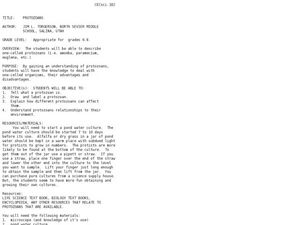Curated OER
Comparing the Amoeba to Paramecium
This laboratory activity is valuable practice in comparing features of different organisms. You could use it to introduce junior biologists to protozoans. The materials and procudures for the learners are simple, and analysis questions...
Curated OER
How Do Single-Celled Organisms Live?
In this single-celled organisms worksheet, students write in how an amoeba, paramecium, and euglena move. Based on these facts, students come to a conclusion about how these organisms live. This worksheet has 4 short answer questions.
Curated OER
Cell Structures and Their Functions
Life science learners investigate live cells. They examine wet mount slides of cyanobacteria and Elodea plants. They peer into the dynamic microscopic world of protists. Afterward, they construct a model of a cell, including rudimentary...
Curated OER
Protists - The Protozoans
Five pages provide thorough coverage of three protozoans: euglena, amoebae, and paramecia. For each, junior biologists read factual text, label the organism, and write answers to several questions. This neatly organized assignment is...
Curated OER
Protist Internet Lab
In this protozoan worksheet, students use the internet research 20 short answer questions about micro-organisms from Amoebas to Parameciums. They also read a poem and write there own based on the researched information.
Curated OER
Protists: animallike Protists
Students are taught that Malaria and African Sleeping sickness are caused by protists. They discuss how animal-like protists harm other living things. Students discuss and listen to the major phyla of animallike protists. They draw...
Casimir Middle School
Biological Classification Worksheet
Classify living things with a set of worksheets that has pupils sorting and indentifying living and non-living things. Learners use the worksheets as a basis for finding their answers.
Cornell University
Thinking with the Eyes
Objects are larger (or smaller) than they appear! Scholars use a laboratory investigation to explore the difference between resolution and magnification. The activity allows them to calculate the size of the field of view of their light...
American Museum of Natural History
The Tree of Life
Groups of species can have more in common than meets the eye. An interactive cladogram shows some of the connections between important groups of species. Learners click on sections of the diagram to learn more about the connections or on...
Curated OER
Cell Structure and Function
Students discuss scientific advances brought about by the Mars Surveyor Space Program which impact on daily life, identify laboratory apparatus like microscopes, slides and coverslips, and use the microscopes to view cells and organisms.
Curated OER
Protozoans
In this protozoans instructional activity, students observe pond water using a microscope to identify the four classes of single-celled organisms including sarcodines, ciliates, flagellates and sporozoans.
Curated OER
Eukaryotic Cell Structure
In this biology activity, learners complete 20 fill in the blank questions about eukaryotic cells. They identify the parts and functions of cell organelles.
Curated OER
Protozoans
Students examine protozoans and their advantages and disadvantages. In this chemistry lesson students explain what a protozoan is then draw and label one.
Curated OER
Protist Crossword
In this protist worksheet, learners complete a crossword puzzle with 34 questions about the behaviour and different types of protists.
Curated OER
Inquiry-based Investigations into Pond Water Microorganisms
Learners become familiar with common microorganisms and experience exploring the microbial world.
Alabama Learning Exchange
It's a Small, Small World
Students compare and contrast the different characteristics of animal-like, plant-like, and fungus-like protists. They list examples and describe the characteristics shared by the three protist groups. They create a brochure or slideshow...
Curated OER
Zoology Word Search Puzzle
In this science worksheet, students look for the words that are related to the concept of zoology that is reviewed in the sheet. They also acquire new vocabulary.
Other popular searches
- Paramecium Euglena Amoeba
- Paramecium, Euglena, Amoeba
- Paramecium, Eugenia, Amoeba
- Paramecium Eugenia Amoeba


















